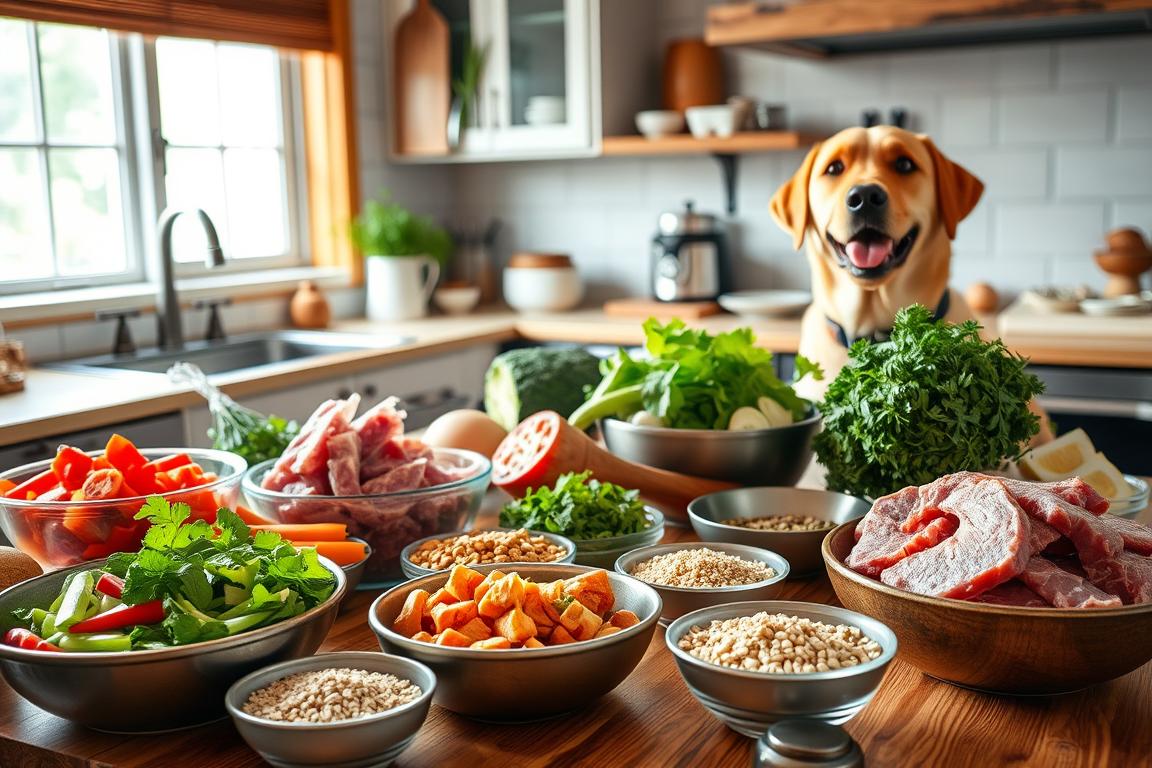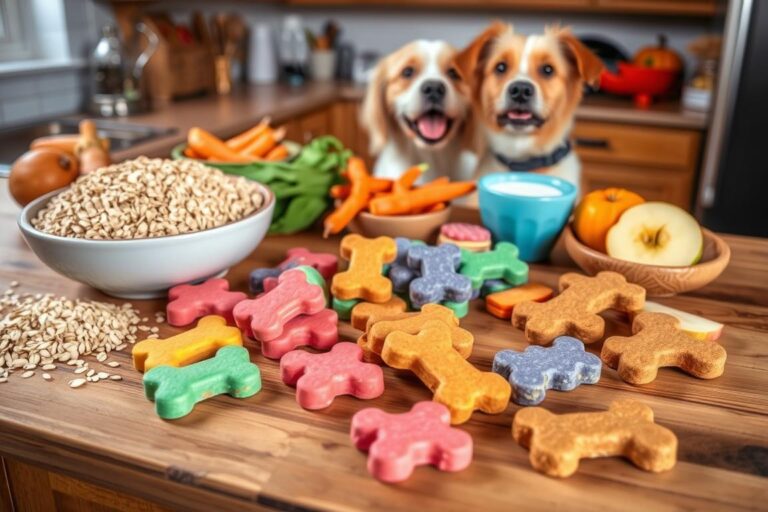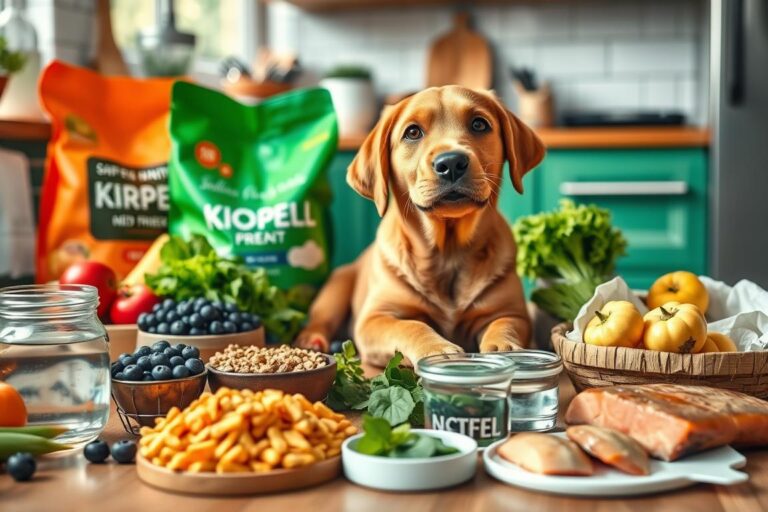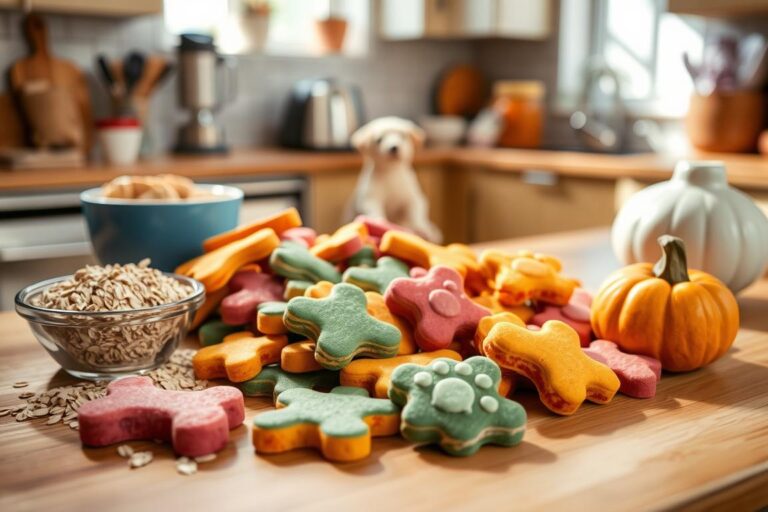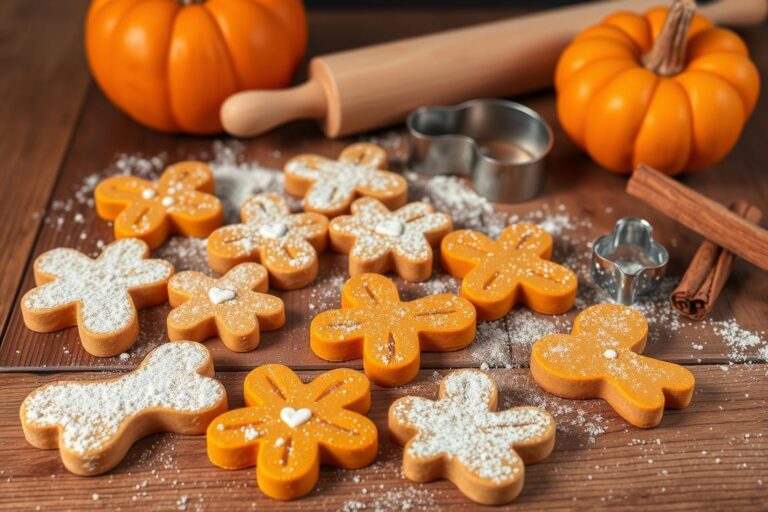Best Homemade Dog Food Recipes for Labrador
We love our Labradors and want the best for them. Making our own dog food is a great way to do this. It lets us choose healthy ingredients that fit our dogs’ needs.
Some think making dog food is hard. But it’s actually easy. We can make meals that our dogs enjoy and that are good for them.
Understanding Canine Nutrition for Labradors
Caring for our Labradors means knowing about their food needs. A good guide tells us what they need to eat. Labradors need lots of protein from foods like chicken and fish for their muscles.
Carbs should make up 50% of their food. Rice and potatoes give them energy and fiber. Fiber comes from veggies like peas and carrots too.
Healthy fats are also key for their health. They need at least 5.5% fat from oils. Adding dog vitamins and minerals makes sure they get everything they need.
Bad homemade diets can harm our dogs. Tufts Cummings Veterinary Medical Center warns about recipes that don’t give enough nutrients. We must be careful with the amounts to keep our dogs healthy.
Why Choose Homemade Dog Meals?
Choosing homemade dog meals has many benefits for our pets and us. We can make sure our Labradors eat the best food. This way, we avoid common allergens in store-bought dog food.
Homemade food lets us tailor meals for our pets’ needs. We can remove foods that cause allergies or upset stomachs. This helps keep our Labradors healthy and happy.
Homemade meals can also save money. Quality ingredients don’t always mean expensive brands. We can use leftovers and affordable meats like grass-fed options. Some even use roadkill or other ethical meats to cut costs.
Our homemade dog food recipes are balanced. They have half meat, a quarter veggies, and a quarter liquids. This makes the food tasty and nutritious. We freeze meals in one-pound packages to save time and reduce waste.
With the right ingredients and simplicity, we see big changes in our dogs. Many owners notice better energy, coat, and health in their pets. Choosing homemade meals makes our Labradors happier and healthier.
Benefits of a Nutritious Labrador Diet
Feeding our Labradors a healthy diet has many benefits. It boosts their energy, making them more active and fun to play with. It also helps their skin and fur stay healthy, avoiding dryness and irritation.
Homemade dog food strengthens their immune system. It keeps them from getting sick often. It also helps fight obesity, a big problem for Labradors, by controlling how much they eat.
Tools like the ChefPaw machine make cooking for our dogs easy. It makes fresh food in just 40 minutes. This saves us time and money, giving our dogs better food.
Working with vet nutrition experts, we can make meals just right for our dogs. This way, we get all the good from homemade food. And our Labradors get the best nutrition every day.
| Benefit | Description |
|---|---|
| Improved Energy Levels | Enhanced activity and vitality through a balanced diet. |
| Better Skin and Coat Health | Reduced dryness and irritation, leading to a shinier coat. |
| Stronger Immune System | Lower susceptibility to illnesses with better nutrition. |
| Weight Management | Control over caloric intake to prevent obesity. |
| Time Efficiency | Fast preparation methods make feeding hassle-free. |
| Personalized Nutrition | Custom meal plans tailored to individual health needs. |
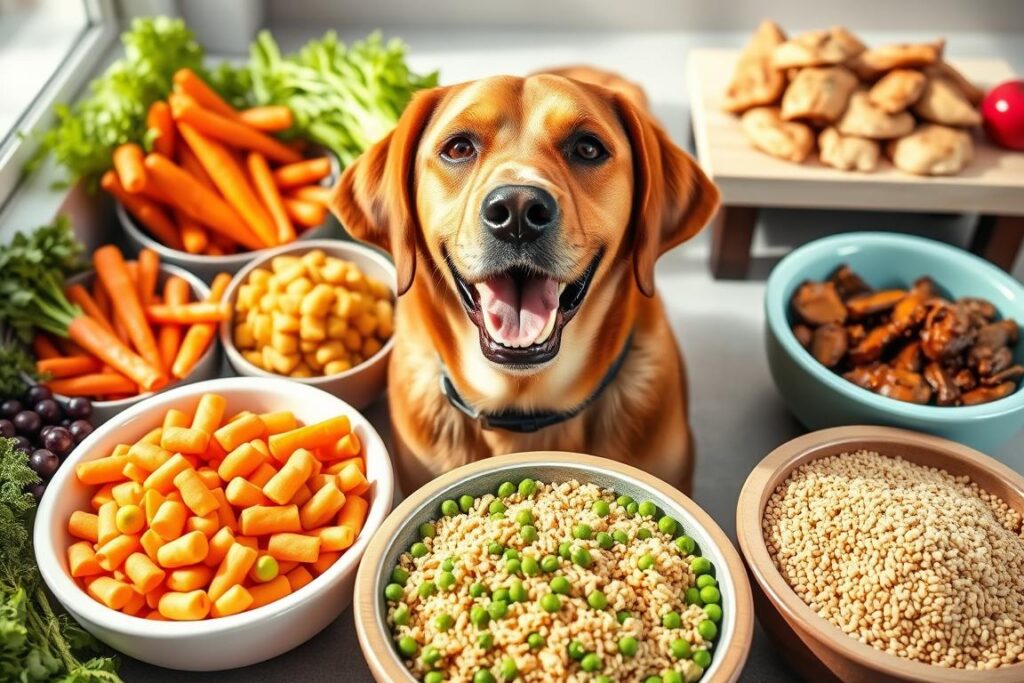
Essential Ingredients for Healthy Dog Food
Making homemade meals for our Labradors means using healthy ingredients. We need high-quality proteins, healthy fats, and lots of veggies. Lean meats like ground beef and turkey give our dogs the amino acids they need.
Healthy fats are also key. Hempseed is a great source of omega-3 and omega-6 fatty acids. These fats help our dogs’ skin and coats. Kelp powder adds iodine, which is good for their teeth and energy.
Vegetables like broccoli and sweet potatoes are full of nutrients. They also help with digestion. But, we must watch out for foods that can cause allergies in dogs. Beef, dairy, and wheat are common culprits.
It’s important to mix up the ingredients for our dogs’ health. Different veggies like carrots and peas add fiber. They also make meals more interesting for our pets.
When prepping meals, remember to store them right. Uncooked food goes in the freezer, and cooked meals in the fridge for four days max. For dogs with kidney disease, meals low in phosphorus are best.
By choosing the right ingredients, we can make meals that are both healthy and tasty. A mix of proteins, fats, and veggies meets our Labradors’ special needs.
Best Homemade Dog Food Recipes for Labrador
We are excited to share some of the best homemade dog food recipes for labrador. These easy dog food recipes meet your lab’s nutritional needs. They also make meal prep easy. Each recipe is made with love, ensuring your furry friend enjoys every bite.
Recipe 1: Turkey and Spinach Delight
This recipe combines ground turkey, spinach, and brown rice. It’s a nutrient-rich meal. Turkeys provide lean protein for muscle health. Spinach offers vitamins and antioxidants. Brown rice gives energy to keep your Labrador active.
Recipe 2: Peanut Butter Pumpkin Paws
Your pup will love these tasty treats! Made with peanut butter and pumpkin, they’re perfect for rewards. Peanut butter adds healthy fats. Pumpkin helps with digestion and keeps your Labrador at a healthy weight.
Recipe 3: Sweet Potato and Rice Mash
This dish features sweet potatoes and whole grains. It’s packed with essential vitamins and nutrients. Sweet potatoes are good for eye health. Rice is a bland carb source, great for sensitive stomachs.
| Recipe | Key Ingredients | Main Benefits |
|---|---|---|
| Turkey and Spinach Delight | Ground turkey, spinach, brown rice | Lean protein, vitamins, energy source |
| Peanut Butter Pumpkin Paws | Peanut butter, canned pumpkin | Healthy fats, digestion aid |
| Sweet Potato and Rice Mash | Sweet potatoes, rice | Vitamins, gentle on stomach |
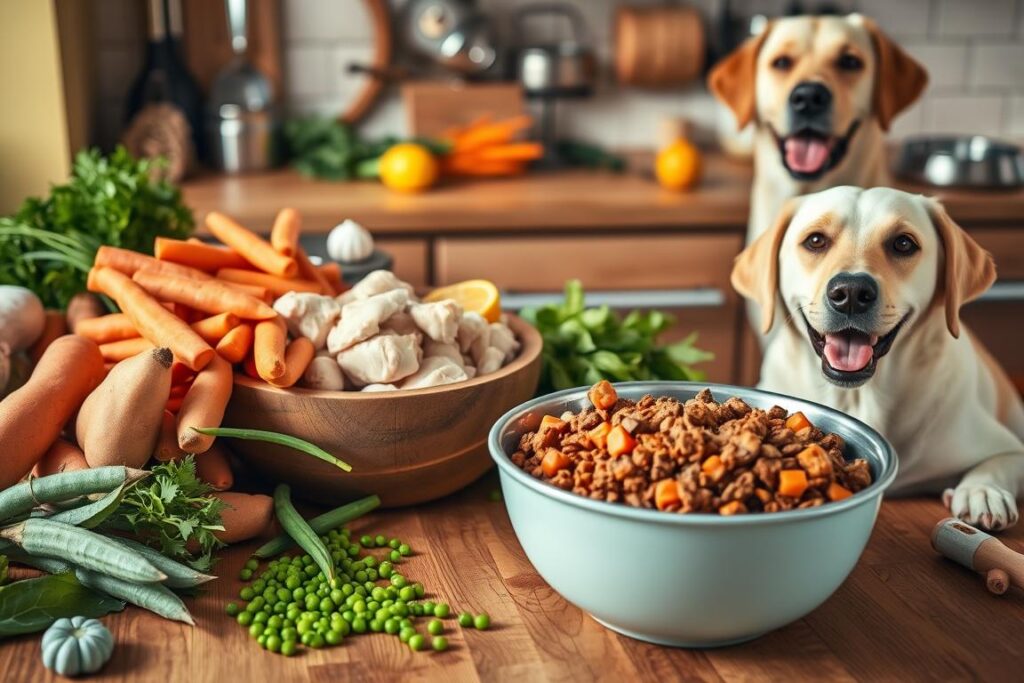
How to Prepare Homemade Dog Food
Preparing homemade dog food needs planning and organization. We must give our Labradors a balanced diet. Meal prep tips can save time and make it easier.
We can batch cook and portion meals. Proper storage and serving suggestions keep food fresh and safe for our pets.
Meal Prep Tips for Dog Owners
Batch cooking is a great first step for dog meal prep. We make about six cups of food per recipe. This is enough for three days for a 45-pound Labrador.
Preparation takes about 30 minutes. This is good for busy people. Clear recipes help us know what to buy, like ground turkey and fresh veggies.
Portioning meals into servings makes them easy to grab during the week. This helps avoid unhealthy snacks.
Storage and Serving Suggestions
Storage and safety are key for homemade dog meals. Use airtight containers to keep food fresh. Meals in the fridge last up to a week.
Frozen leftovers stay good for three months. When switching to homemade food, start with small amounts. Mix it with their regular food for a few days.
Watch for any upset stomachs during this time. It’s important to monitor their reactions.
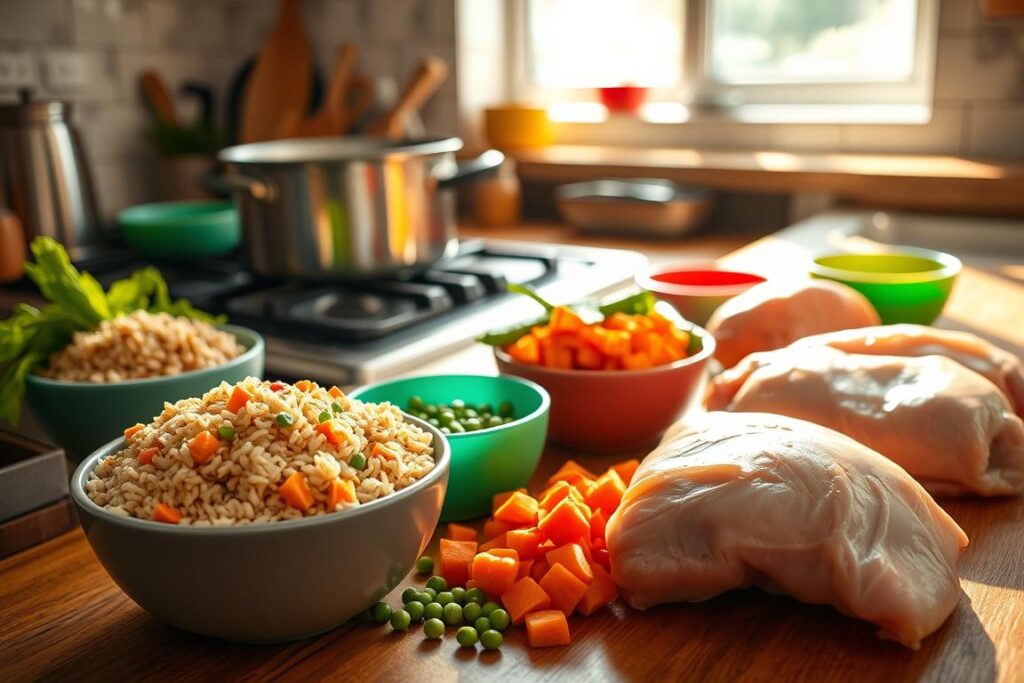
| Storage Method | Duration | Temperature |
|---|---|---|
| Refrigerator | Up to 1 week | Below 40°F |
| Freezer | Up to 3 months | 0°F or lower |
By following these tips, we ensure our Labradors get nutritious meals. Cooking becomes enjoyable and efficient. Quality ingredients and safe storage make our dogs happy and healthy.
Balanced Dog Diet: Ratios to Consider
Creating a balanced dog diet is key for our Labradors’ health. We focus on the right dog nutrition ratios. A balanced diet has protein, carbs, and veggies in the right amounts.
This mix gives our dogs the energy and health they need.
For a balanced diet, we aim for about
| Component | Percentage of Diet |
|---|---|
| Protein | 40% |
| Carbohydrates | 50% |
| Vegetables/Fiber | 10% |
This ratio helps with muscle and energy. Protein is key for puppies, pregnant dogs, and those getting better. We can use animal meats or make special recipes for dogs with needs like cancer.
How much food our dogs need depends on their size, activity, and health. We must adjust their food based on their weight and health checks. Watching their ribs and waist helps us know if we need to change their food.
Talking to a vet or pet nutritionist is helpful. They can guide us on the right dog nutrition ratio. Following AAFCO guidelines helps us make sure our dogs get all the vitamins and minerals they need. This way, we can keep our Labradors healthy and happy.
Labrador Feeding Tips for Optimal Health
Feeding our Labradors is key to their health. We need to know their special needs. This helps us feed them right, keeping them strong and full of energy.
Puppies need four meals a day until they are six months old. This helps them grow fast and stay active.
When they grow up, we can feed them twice a day. We should give them food based on their size and how active they are. Eukanuba gives good tips, but we might need to give less food if they are too heavy.
Labradors should eat their food in ten minutes. This helps prevent bloating. Using a slow feed bowl helps them eat slower. But, we should not give them bad foods like onions or chocolate.
It’s important to give them the right amount of bones. Bones like ribs or necks are good for chewing and teeth. Raw dog food has about 10-15% bone, but we can change this based on our dog’s needs.
Drinking water is very important for them. Whether we make food at home or use kibble, they always need fresh water. Taking them to the vet regularly helps us make sure their diet is right for them. Following these tips helps our Labradors live long, happy lives.
Common Mistakes to Avoid in Dog Meal Prep
When we start making meals for our Labradors, we must watch out for common mistakes. One big mistake is using too many fillers. These can make our pets’ meals less nutritious. We should aim for meals that are mostly meat, with some organ meat, and a bit of veggies and fruits.
It’s also important to balance the nutrition in our dogs’ meals. Adult dogs need about 2-3% of their body weight in food each day. Recipes can vary, but knowing how to mix the right amounts is key.
Choosing the right ingredients is another critical step. Some foods are bad for dogs, like cooked bones, avocado, chocolate, and grapes. Always check with a vet before adding new foods to our dogs’ diets. This keeps our pets safe and healthy.
Monitoring Your Dog’s Reaction to Homemade Meals
When we start giving homemade meals to our Labradors, we need to watch closely. We look for signs of health like more energy, shiny fur, and regular bowel movements. But, if our dog seems tired, has a tummy upset, or shows allergy signs, we might need to change the recipe.
It’s important to know how our dog reacts to new foods. Most homemade diets lack important nutrients. Even good recipes can miss out on vitamins A, D, and B complex. This can make our dog tired and affect their health over time, especially for puppies and nursing moms.
Knowing what our Labrador needs helps us make a good meal plan. By watching how they react to our recipes, we can make the right changes. This way, our pets stay healthy and happy. A good diet is just as crucial for them as it is for us.

